The Lincoln Memorial is an American national memorial built to honor the 16th President of the United States, Abraham Lincoln. It is located on the western end of the National Mall in Washington, D.C., across from the Washington Monument. The architect was Henry Bacon; the designer of the primary statue – Abraham Lincoln, 1920 – was Daniel Chester French; the Lincoln statue was carved by the Piccirilli Brothers; and the painter of the interior murals was Jules Guerin. Dedicated in May 1922, it is one of several memorials built to honor an American president. It has always been a major tourist attraction and since the 1930s has been a symbolic center focused on race relations.
![]()
The building is in the form of a Greek Doric temple and contains a large seated sculpture of Abraham Lincoln and inscriptions of two well-known speeches by Lincoln, The Gettysburg Address and his second inaugural address. The memorial has been the site of many famous speeches, including Martin Luther King Jr.'s "I Have a Dream" speech, delivered on August 28, 1963, during the rally at the end of the March on Washington for Jobs and Freedom.
The exterior of the Memorial echoes a classic Greek temple and features Yule marble quarried from Colorado. The structure measures 189.7 by 118.5 feet (57.8 by 36.1 m) and is 99 feet (30 m) tall. It is surrounded by a peristyle of 36 fluted Doric columns, one for each of the 36 states in the Union at the time of Lincoln's death, and two columns in-antis at the entrance behind the colonnade. The columns stand 44 feet (13 m) tall with a base diameter of 7.5 feet (2.3 m). Each column is built from 12 drums including the capital. The columns, like the exterior walls and facades, are inclined slightly toward the building's interior. This is to compensate for perspective distortions which would otherwise make the memorial appear to bulge out at the top when compared with the bottom, a common feature of Ancient Greek architecture.
The Memorial is anchored in a concrete foundation, 44 to 66 feet (13 to 20 m) in depth, constructed by M. F. Comer and Company and the National Foundation and Engineering Company, and is encompassed by a 187-by-257-foot (57 by 78 m) rectangular granite retaining wall measuring 14 feet (4.3 m) in height.
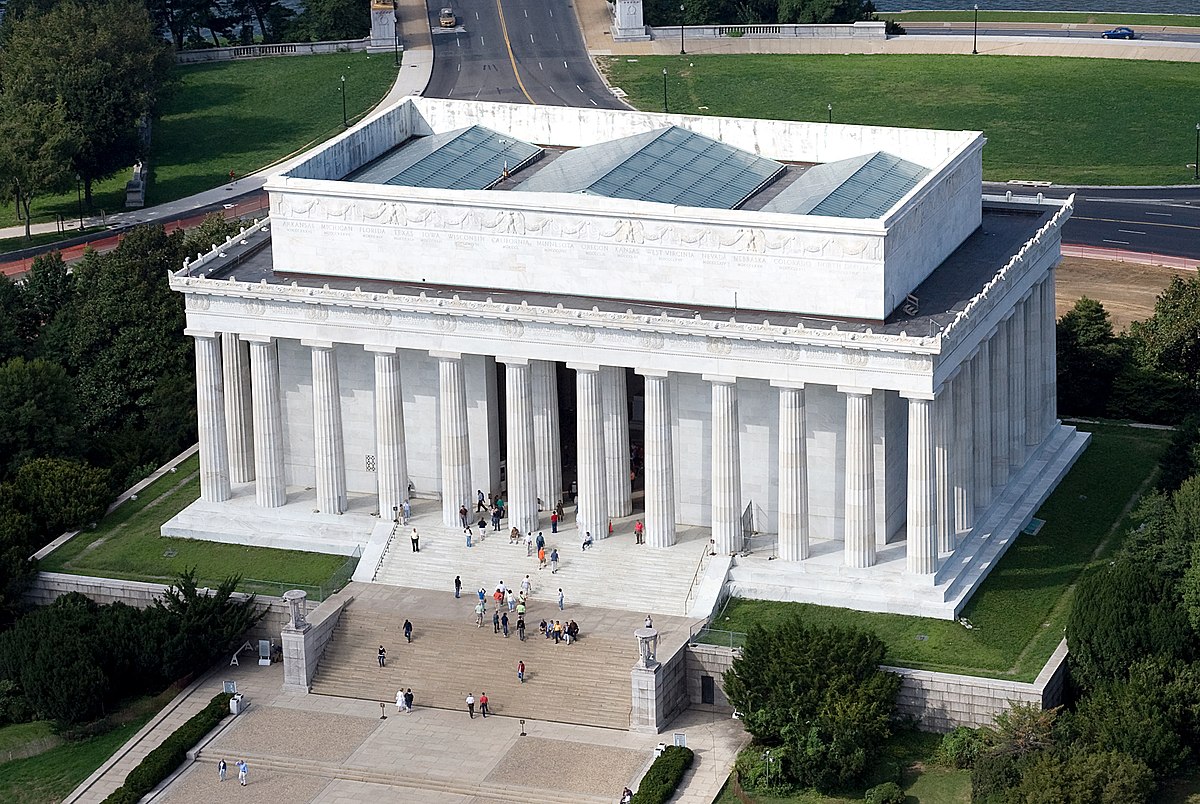
Leading up to the shrine on the east side are the main steps. Beginning at the edge of the Reflecting Pool, the steps rise to the Lincoln Memorial Circle roadway surrounding the edifice, then to the main portal, intermittently spaced with a series of platforms. Flanking the steps as they approach the entrance are two buttresses each crowned with an 11-foot (3.4 m) tall tripod carved from pink Tennessee marble by the Piccirilli Brothers.
The Memorial's interior is divided into three chambers by two rows of four Ionic columns, each 50 feet (15 m) tall and 5.5 feet (1.7 m) across at their base. The central chamber, housing the statue of Lincoln, is 60 feet wide, 74 feet deep, and 60 feet high. The north and south chambers display carved inscriptions of Lincoln's second inaugural address and his Gettysburg Address. Bordering these inscriptions are pilasters ornamented with fasces, eagles, and wreaths. The inscriptions and adjoining ornamentation are by Evelyn Beatrice Longman.
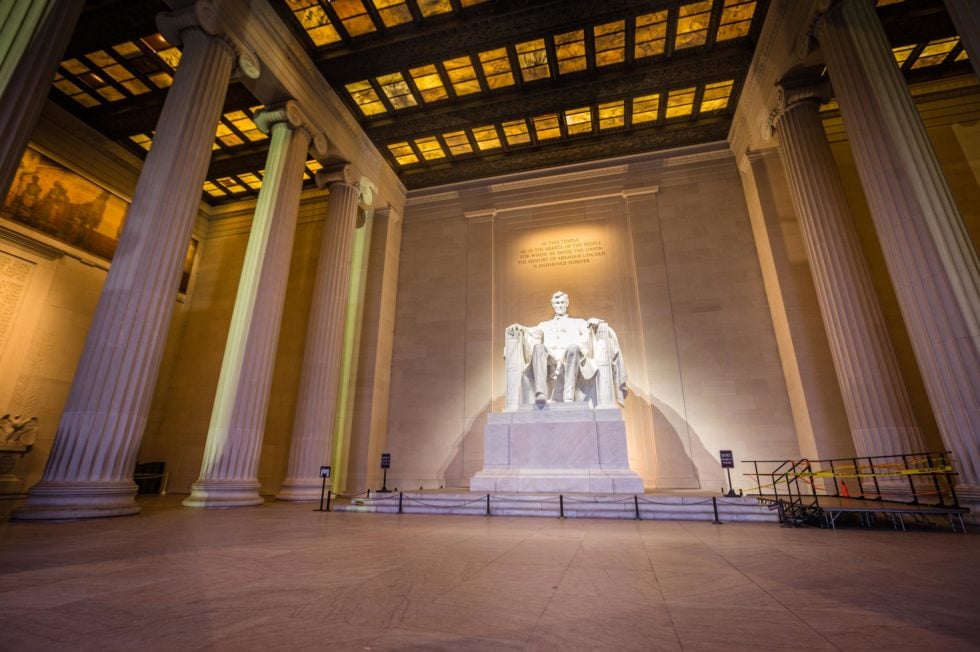
The Memorial is replete with symbolic elements. The 36 columns represent the states of the Union at the time of Lincoln's death; the 48 stone festoons above the columns represent the 48 states in 1922. Inside, each inscription is surmounted by a 60-by-12-foot (18.3 by 3.7 m) mural by Jules Guerin portraying principles seen as evident in Lincoln's life: Freedom, Liberty, Immortality, Justice, and the Law on the south wall; Unity, Fraternity, and Charity on the north. Cypress trees, representing Eternity, are in the murals' backgrounds. The murals' paint incorporated kerosene and wax to protect the exposed artwork from fluctuations in temperature and moisture.
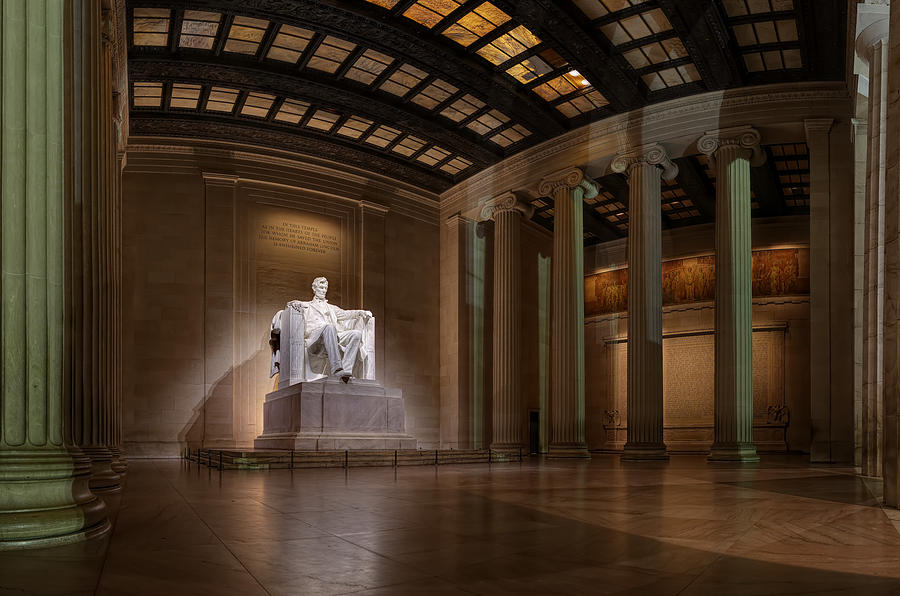
The ceiling consists of bronze girders ornamented with laurel and oak leaves. Between these are panels of Alabama marble, saturated with paraffin to increase translucency. But feeling that the statue required even more light, Bacon and French designed metal slats for the ceiling to conceal floodlights, which could be modulated to supplement the natural light; this modification was installed in 1929. The one major alteration since was the addition of a handicapped elevator in the 1970s.
Lying between the north and south chambers of the open-air Memorial is the central hall, which contains the large solitary figure of Abraham Lincoln sitting in contemplation. Its sculptor, Daniel Chester French, supervised the Piccirilli Brothers in its construction, and it took four years to complete.
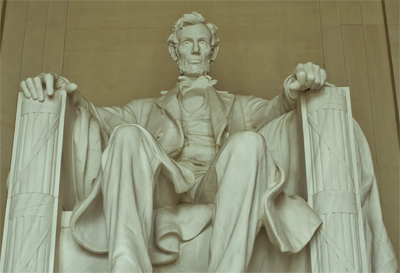
The 175 short tons (159 t) statue, carved from Georgia white marble, was shipped in twenty-eight pieces.[13] Originally intended to be only 10 feet (3.0 m) tall, on further consideration the sculpture was enlarged to 19 feet (5.8 m) from head to foot. If Lincoln were depicted standing he would be 28 feet (8.5 m) tall.

The widest span of the statue corresponds to its height, and it rests upon an oblong pedestal of Tennessee marble 10 feet (3.0 m) high, 16 feet (4.9 m) wide, and 17 feet (5.2 m) deep. Directly beneath this lies a platform of Tennessee marble about 34.5 feet (10.5 m) long, 28 feet (8.5 m) wide, and 6.5 inches (0.17 m) high. Lincoln's arms rest on representations of Roman fasces, a subtle touch that associates the statue with the Augustan (and imperial) theme (obelisk and funerary monuments) of the Washington Mall. The statue is discretely bordered by two pilasters, one on each side. Between these pilasters, and above Lincoln's head, is engraved an epitaph of Lincoln by Royal Cortissoz.
The sculpture has been at the center of two urban legends. Some have claimed that the face of General Robert E. Lee was carved onto the back of Lincoln's head, and looks back across the Potomac toward his former home, Arlington House, now within the bounds of Arlington National Cemetery. Another popular legend is that Lincoln is shown using sign language to represent his initials, with his left hand shaped to form an "A" and his right hand to form an "L", the president's initials. The National Park Service denies both legends.
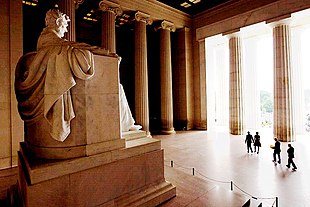
However, historian Gerald Prokopowicz writes that, while it is not clear that sculptor Daniel Chester French intended Lincoln's hands to be formed into sign language versions of his initials, it is possible that French did intend it, because he was familiar with American Sign Language, and he would have had a reason to do so, that is, to pay tribute to Lincoln for having signed the federal legislation giving Gallaudet University, a university for the deaf, the authority to grant college degrees. The National Geographic Society's publication "Pinpointing the Past in Washington, D.C." states that Daniel Chester French had a son who was deaf and that the sculptor was familiar with sign language. Historian James A. Percoco has observed that, although there are no extant documents showing that French had Lincoln's hands carved to represent the letters "A" and "L" in American Sign Language, "I think you can conclude that it's reasonable to have that kind of summation about the hands."
As one of the most prominent American monuments, the Lincoln Memorial is often featured in books, films, and television shows that take place in Washington; by 2003 it had appeared in over 60 films, and in 2009, Mark S. Reinhart compiled some short sketches of dozens of uses of the Memorial in film and television.